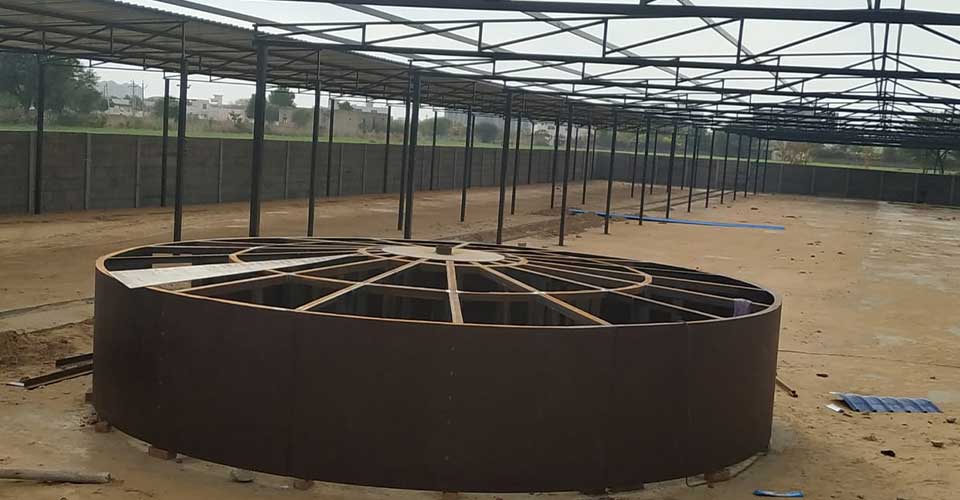Biogas Plant Installation at Hingoniya Gaushala, Jaipur – By Sai Nath Renewable Energy Pvt. Ltd.
At SNRE, we believe in creating sustainable solutions that deliver measurable results. From biogas plant installations in Gaushalas to large-scale solar and waste management projects, our case studies showcase real-world applications of renewable energy across India. Discover how we help communities and industries reduce carbon footprints while promoting clean energy and eco-friendly practices.
India, known for its cultural and religious diversity, has a deep-rooted reverence for cattle, especially cows. With the world’s largest cattle population, India treats cows not just as agricultural assets but also as sacred animals. Slaughtering of cows is banned in most parts of the country. To safeguard cattle, the Animal Welfare Board of India (AWBI) and various state governments actively support and run Gaushalas (cow shelters).
Gaushalas serve as traditional shelters for abandoned, infertile, aged, or rescued cows, providing lifelong care until natural death. However, managing Gaushalas involves significant operational expenses—such as feeding, medical care, shelter maintenance, staff salaries, and electricity. Although some funding comes from central and state governments, Gaushalas often rely on private donors and individuals for additional support.
Biogas Plant Implementation by SNRE
To manage cow dung sustainably while generating renewable energy, SNRE (Sai Nath Renewable Energy) introduced a 240 cubic meter biogas plant at a Gaushala. This plant not only helps in waste management but also provides clean energy, supporting the shelter’s daily operational needs.
Biogas Process Overview:-
Biogas is generated through the anaerobic digestion of organic waste, such as cow dung, where bacteria decompose the material without oxygen. This process generates methane (CH4), carbon dioxide (CO2), hydrogen sulfide (H2S), carbon monoxide (CO), water, and fiber residue.
Plant Capacity & Setup:
-
Total Plant Capacity: 240 cubic meters
-
Biogas Output: Produces biogas equivalent to 120 kg of LPG per day (with 1 m³ of biogas roughly equal to 0.465 kg of LPG).
-
Digesters: 4 units, each with 60 m³ capacity
-
Daily Input per Digester: 1500 kg cow dung + 1500 liters of water (3000 liters of slurry total)
-
Hydraulic Retention Time (HRT): 45 days retention period as per the standard KVIC floating dome biogas plant design.
Technical Components:-
-
Mixing System (Agitator):
Manual mixing of large volumes of cow dung was labor-intensive. SNRE introduced a mechanical agitator system to streamline operations. The mixing platform is designed to allow easy loading of cow dung from tractors, significantly reducing manual effort.
-
Agitator Specs:-
-
7.5 HP, 3-phase motor
-
3 mixing blades (12 mm MS flats)
-
18 mm solid MS rod with bearings and brass bush supports
-
Operates at 50-120 RPM to prevent splashing and ensure uniform slurry mixing
-
-
Slurry Feeding Process:
Each mixing cycle (tractor unloading, slurry preparation, and feeding) takes approximately 45–55 minutes per digester, totaling 4 to 5 hours for all 4 digesters. Four outlet gates control the slurry flow into the respective digesters.
-
Gas Collection & Distribution:
Biogas is collected through a floating dome system and transported via GI pipelines to:
-
A low-pressure compressor
-
A scrubber for gas purification
-
Direct supply to the kitchen and DG set via CPVC pipelines with ball valves for pressure control
Impact & Benefits:
-
Efficient management of 6000 kg of cow dung daily
-
Generation of renewable, clean cooking gas and fuel for DG sets
-
Reduction in labor and operational time
-
Sustainable waste-to-energy conversion supporting Gaushala’s operational costs
SNRE’s biogas plant installation in the Gaushala represents a model of sustainable energy and waste management. This project not only addresses religious and social responsibilities but also contributes to a circular economy, reducing dependency on conventional fuel and minimizing environmental impact.

